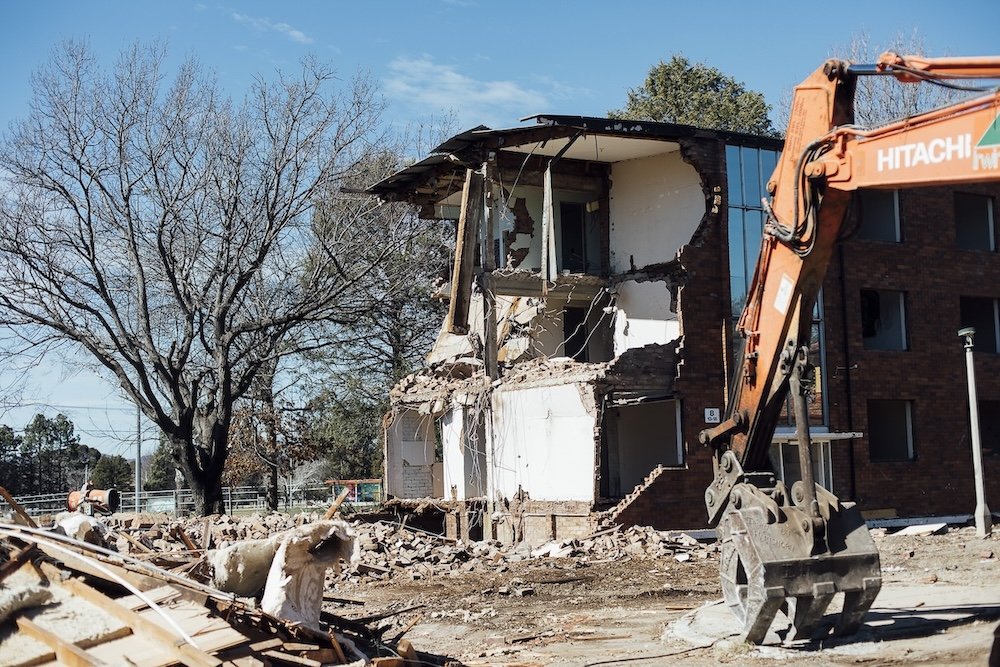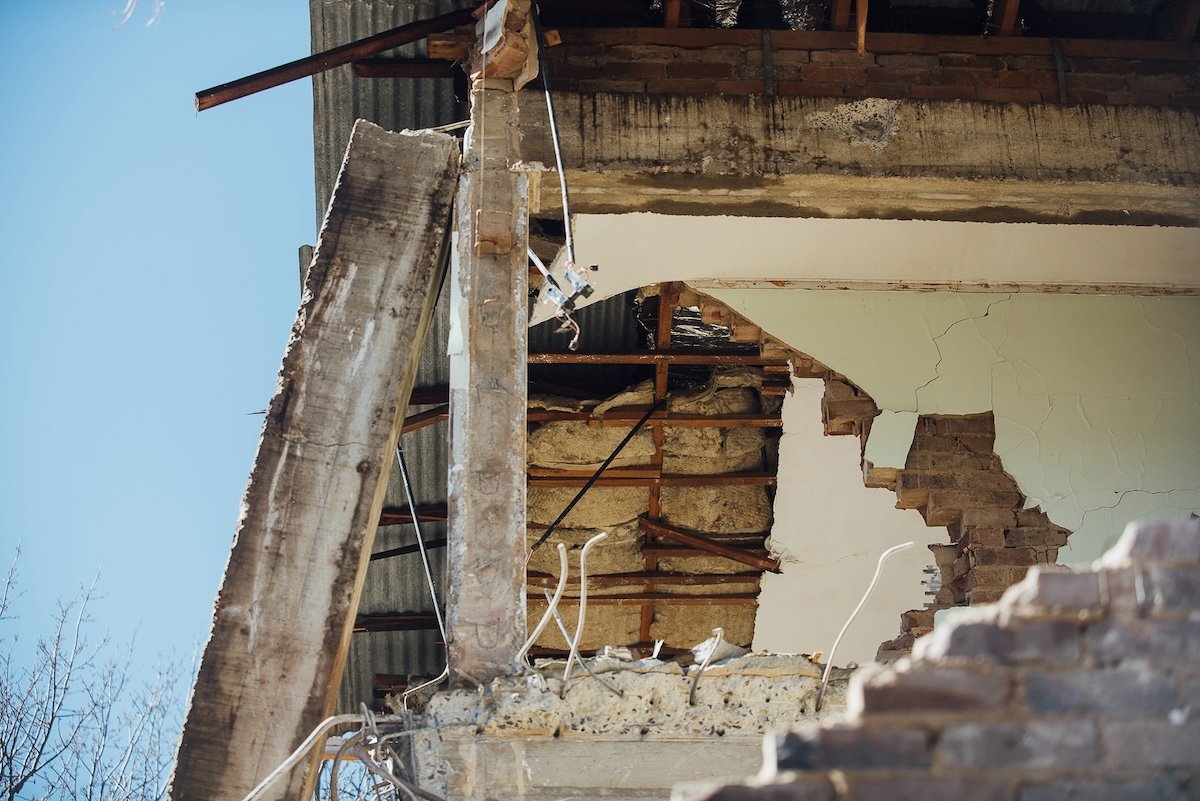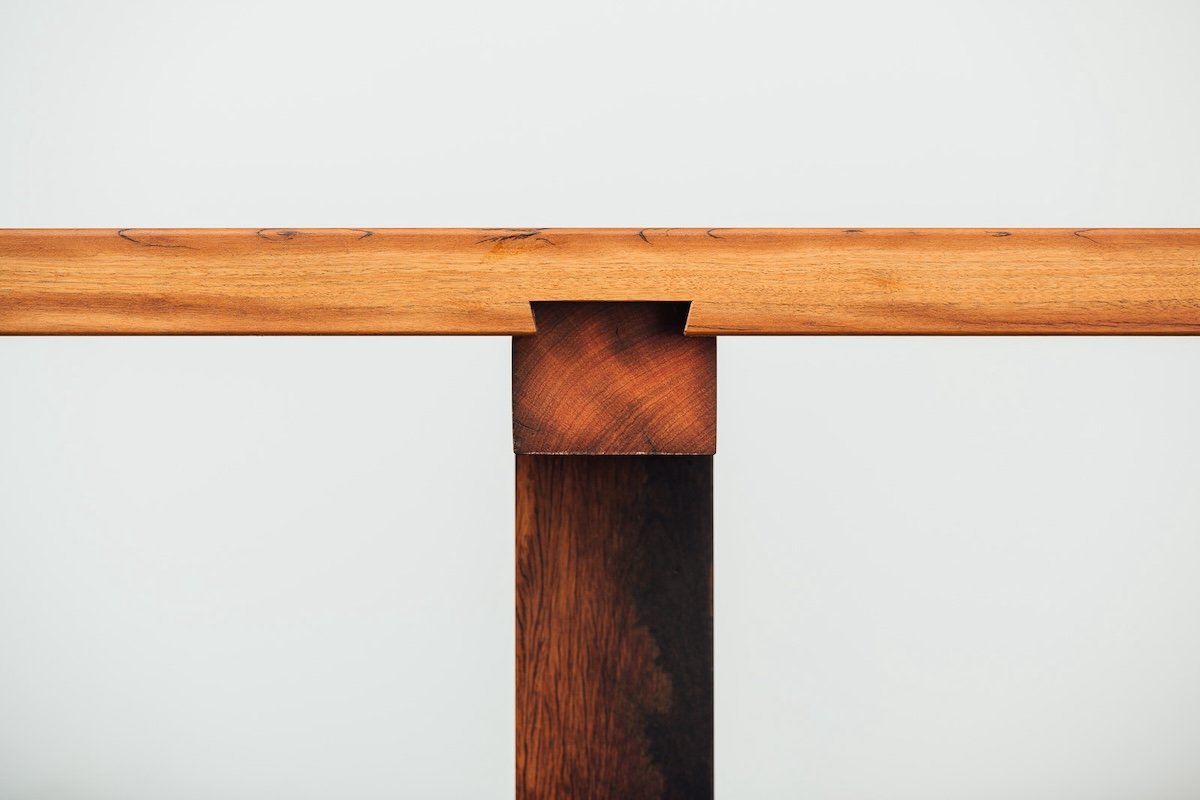Four-by-Two: Our Most Versatile Salvaged Timber Stock
February 2025
If you’ve ever pulled apart an old house, you’ve probably come across four-by-two timber stock. It’s everywhere—hidden in roof spaces, holding up floors, framing walls. This stock, measuring 100x50mm (4x2 inches), has been known as ‘four-by-two’ for hundreds of years, and it was the go-to size in Australian construction for rafters, joists, bearers, and more, up until the 1970’s.
When we salvage this timber, it has typically spent 50 to 100 years in the concealed structure of a building, naturally drying and hardening over time. This seasoning process results in stable, dense hardwood, making it ideal for reuse. And because four-by-two was used so widely in construction, reclaiming it allows us to put large volumes of high-quality hardwood back into circulation—reducing waste, lowering demand for freshly milled timber, and keeping a valuable resource in use for another lifetime.
Salvaging, Processing & Sorting
The process of salvaging four-by-two timber starts on the demolition site, where our demolition partners or in-house team carefully dismantle old buildings to recover high-quality timber before demolition waste is sent to landfill. We remove salvageable sections intact, ensuring as much timber as possible is reclaimed in lengths suitable for reuse.
Once at our workshop, the recycling team begins processing. Each load is assessed to determine the best recycling approach, as some timbers arrive in rougher condition and require extra work to prepare. It is then denailed, metal-detected, and docked to remove unusable sections before being sorted by species.
Our sorting process follows the same logic as Australia’s early sawmilling operations. In the past, sawmills would cut whatever timber came out of the forest and send it to builders as a mixed batch, rather than sorting it by species. This made sense, as many Australian hardwoods share similar structural and visual properties, so there was no practical need to separate them.
Because of this, most batches of four-by-two timber we salvage today contain between five and fifteen different species. Some of these we group together based on strength, durability, and often colour, while others are sorted into separate species packs.
Our four-by-two timber stock comes in a wide range of Australian hardwoods, each with its own distinct character. We regularly salvage blackbutt, spotted gum, blue gum, tallowwood, ash, and brushbox, along with other durable timbers that have been part of Australian buildings for decades.
Recycling Manager Matt processing and recycling naily timber for resuse.
A huge stack of 100mm x 50mm Canberra Local Ash.
Flooring, Cladding & Decking
After the recycling team has finished processing and sorting the stock, our dressing team steps in, sawing a portion of the stock in half lengthwise and storing as blanks, ready for re-milling into architectural products—flooring, cladding (including lining boards), and decking.
Four-by-two's sawn in half and stickered out ready for drying in our solar kiln. Next they will be machined as needed into flooring, decking or cladding profiles.
Flooring
Our re-milled flooring is a great option if you want a fresh, clean look but with the texture and history of recycled timber. The freshly milled tongue and groove makes them easy to install and ensures a precise, snug fit between boards.
We typically produce 78mm-wide floorboards, planed to a smooth 18mm thickness or left with a sawtooth finish at 19mm. The clean-dressed option highlights the timber’s natural colour and grain, while sawtooth retains the original saw marks for a more rustic, textured look.
Re-milled flooring can be made in most of our timber species. Blackbutt and spotted gum are popular choices for their durability and rich colouring (although we rarely salvage enough spotted gum for a run of flooring), while brushbox and blue gum offer more of a deep, warm tone. Canberra local ash is another option if you’re looking for a lighter, more neutral option.
Cladding & Lining Boards
Cladding and lining boards are another popular use for four-by-two stock. Cladding is designed for exterior walls, providing both protection and aesthetics, while lining boards are used internally to add texture and warmth to walls and ceilings.
Our thinner tongue & groove (T&G) lining boards, often used indoors or in protected outdoor areas, can be finished with either a v-joint or a shadowline profile.
Square edge cladding is another good interior option, with rough sawn edges giving this cladding profile a raw, natural aesthetic. Often combined with a sawtooth finish to accentuate the rustic charm.
Batten cladding and screening is suitable for both interior and exterior use, and is designed with a central groove that creates a bold, modern look.
Our shiplap cladding is a versatile option that works both inside and out, whether installed vertically or horizontally. For a vertical look, we can run a square profile to keep the lines sharp and clean. The overlapping boards add built-in weather protection, and you can choose from rough sawn, sawtooth, or clean-dressed finishes to get the right texture for your space. When installed horizontally, cladding needs to have an angled profile to shed water to the outside.
For cladding, we recommend durable species like blackbutt and ironbark for external applications due to their high durability and weather resistance. For inside, our recommendations are similar to those for flooring; brushbox, spotted gum and blue gum for their rich colour variations, and Canberra local ash for a blonde look.
Years ago, we did a project at Campbell 5, supplying recycled timber for external cladding for their Display Office & Gallery. Chase Building fixed a mix of various sizes onto a weatherproof plywood lining with roofing screws, achieving a really interesting, layered look. In the mix you can see 100x50mm, 100x25mm and 100 x 75mm boards, all with a rustic sawtooth finish. Another interesting example of the four-by-twos in action!
Decking
Decking is another smart use for four-by-two timber (after ripping it to four-by-one’s). Choose from clean-dressed or rough sawn and wire-brushed decking, depending on your style preferences and how the deck will be used.
Clean-dressed boards are planed back, revealing the colour and grain of the timber. This option is the easiest to install and maintain, and also (as the name suggests), has a sharper, cleaner aesthetic overall.
If you prefer a textured finish though, our rough sawn and wire-brushed decking provides a rustic, lightly burnished look—ideal for pergolas, verandahs, and outdoor spaces. The rough sawn surface also offers better grip, though it may need a little extra maintenance over time to prevent small splinters from appearing.
Species for decking timbers need to be extremely dense and durable, so we recommend either our blackbutt / dense browns, or our ironbark / dense reds hardwoods mix.
In this video, Matt from Recycling talks you through turning a piece of four-by-two timber into re-milled flooring.
Video: Tideline Productions
Furniture & Joinery
Another option for four-by-two stock is to store it as-is, ready to be picked for joinery and furniture projects. This allows for greater flexibility, especially for solid timber furniture makers and custom joinery applications.
Benchtops
Four-by-two stock is a great option for solid timber benchtops, offering both strength and visual appeal. Once dressed back straight and square, these timbers are joined together to create sturdy, stable surfaces with a distinctive recycled timber character.
The finished boards typically end up around 75-80mm wide, and can be laminated up to make benchtops in any width, allowing the grain and colour variation to shine through. A fully clean-dressed and fine-sanded benchtop finishes at 37mm thick—ideal for kitchen islands or worktops.
For a more textured finish, we can lightly dress the boards to retain some of the original saw marks, creating a sawtooth finish at around 44-46mm thick, then resin-fill any resulting unevenness. This option keeps some of the rustic patina from the timber’s previous life while still offering a smooth, practical surface.
The stability of these timber benchtops makes them a great choice for high-use areas like kitchens, dining tables, and workstations.
This project features over 450 individual blocks of four-by-two timber boards, facing upwards to create an extremely strong and durable kitchen benchtop. First we constructed a long benchtop, cut it into short lengths, and reassembled it with the end grain exposed.
Photos: Rohan Venn + Ellie Keft
Tables
Salvaged four-by-two timbers are ideal for solid timber table tops, whether for dining, office, or communal spaces. The naturally seasoned and dense nature of the timber provides long-lasting durability, while the range of species available offers rich colour variation and unique grain patterns.
Tables can be made from single-species tops or mixed hardwoods for a more varied and textured aesthetic. Whether finished in a clean-dressed, lightly sanded look or with a sawtooth finish to highlight the timber’s past life, these timbers create statement pieces built to last.
Doors
Recycled four-by-two stock is perfect for crafting solid timber doors, from internal passage doors to statement entry doors. The density and durability of salvaged Australian hardwoods make for strong, stable door panels that hold up well over time.
Depending on the aesthetic, doors can be made entirely from a single species, or a mix of hardwoods for added variation. The timber can be left clean-dressed for a refined finish or feature a more rustic sawtooth effect.
Custom Furniture & Joinery
From shelving to built-in cabinetry, four-by-two timber is a versatile choice for custom furniture and architectural joinery. The timber’s dimensional stability and durability make it suitable for a wide range of applications, from bookshelves and kitchen cabinetry to feature wall panelling and storage units.
Because of the variety of species available, it’s possible to create custom pieces that suit modern, rustic, or classic interiors, making the most of the depth and texture of recycled hardwood.
The four-by-two is a workhorse of our recycled timber operation—versatile, abundant, and full of potential. Because it’s one of the most common sizes we salvage, having the right expertise and setup makes all the difference in how much of it we can reuse.
At Thor’s Hammer, our advantage lies in the way our business is structured. Under one roof, we have an extremely skilled and well-resourced recycling team, plus a team of designers and salespeople who actively develop products around the stock sizes we salvage. This means we’re able to reclaim, process, and sell as much of this timber as possible—maximising its value and keeping it in circulation.
Without this streamlined operation, we’d have fewer ways to use four-by-two timber, and more of it would end up in landfill, wood chip, or pulp. Instead, we’re able to turn it into flooring, cladding, decking, furniture, and joinery—extending its life for decades to come.
If you’re wondering if you can incorporate this recycled timber into your next project, get in touch with our team today. Call (02) 9161 6793, email hammer@thors.com.au , or fill out an enquiry form via the button below.
Words by Ellie Keft. Photos by Rohan Thomson unless otherwise stated.




































































